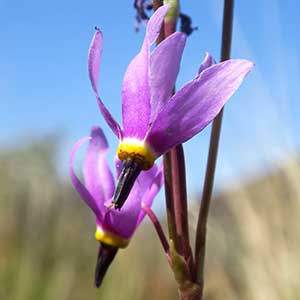Dodecatheon conjugens
Dodecatheon poeticum
Bonneville shooting star, desert shootingstar, slim-pod shooting star
narcissus shooting star, poet's shooting star
not obvious at anthesis;
roots whitish;
bulblets absent.
not obvious at anthesis;
roots white;
bulblets usually present.
3–13(–18) × 0.7–2.5(–4) cm;
petiole slender (at least proximally);
blade narrowly oblanceolate to spatulate or obovate, base usually not decurrent onto stem, usually abruptly tapering to petiole, margins entire, surfaces glabrous or glandular-puberulent.
(3–)5–16(–20) × 0.5–2.5(–3) cm;
petiole usually winged;
blade oblanceolate to spatulate, base usually decurrent onto stem, gradually tapering to petiole, margins usually entire, sometimes denticulate to slightly toothed, surfaces glandular-pubescent.
1–7(–10)-flowered;
bracts lanceolate to broadly lanceolate, 3–10 mm, glandular-puberulent.
2–10(–17)-flowered;
bracts narrowly to broadly lanceolate, 2–10 mm, glandular-pubescent.
1–5 cm, glabrous or glandular-puberulent.
1–3.5 cm, glandular-pubescent.
calyx light green to yellowish, sometimes finely purple-speckled or -dotted, 5–12 mm, glabrous or glandular-puberulent, tube 2–6 mm, lobes 5, 3–7 mm;
corolla tube yellowish with purplish red, thin, wavy ring, lobes 5, usually magenta, sometimes white, 7–25(–35) mm;
filaments usually distinct, yellowish or dark maroon, 0.5–1.5 mm, rarely partially connate and tube 0.5–1.5 × 1.5–5 mm;
anthers 5–9 mm;
pollen sacs usually maroon or yellow, sometimes yellowish and speckled maroon, rarely with reddish purple to purple speckles, connective usually maroon, sometimes yellowish or light blue to whitish, transversely rugose;
stigma not enlarged compared to style.
calyx greenish, often with pinkish purple to purple speckles, 5–9 mm, glabrous or slightly glandular at least along margins, tube 2–4(–5) mm, lobes 5, 3–5 mm;
corolla tube maroon and yellow with reddish, thin, wavy ring, lobes 5, magenta to lavender, (8–)10–15(–18) mm;
filaments connate, tube maroon, 1.5–3 × 2–3 mm;
anthers 4–7 mm;
pollen sacs maroon to black, connective deep purple to black, transversely rugose (sometimes seemingly smooth [when immature] or transversely wrinkled [when dried]);
stigma not enlarged compared to style.
tan, often striped with purple, usually operculate, rarely valvate, cylindric-ovoid, 8–17(–22) × 4–6(–8) mm, glabrous;
walls thin, pliable.
tan, often faintly reddish apically, valvate, short-ovoid, 6–9 × 4–7 mm, glandular-pubescent;
walls usually thick and firm.
without membrane along edges.
without membrane along edges.
= 44.
= 44, 88.
Dodecatheon conjugens
Dodecatheon poeticum
Varieties 2 (2 in the flora).
Both Dodecatheon conjugens and D. poeticum occur in proximity in the Columbia River gorge. Some specimens here assigned to var. conjugens may have scattered, minute glands on the pedicels that might indicate past hybridization with D. poeticum (e.g., G. N. Jones 6286, ORE; R. R. Halse 3790, OSC, WTU). Dodecatheon poeticum is densely glandular not only on the pedicels, but also on the calyx and scape. The type of minute glandular puberulence seen on var. conjugens found along the Columbia River west of The Dalles is somewhat similar to that seen on var. viscidum in western Montana and Canada. Some plants referred here to D. conjugens have slightly connate filaments that may indicate some intergradation with D. pulchellum var. pulchellum. This suggestion is supported by the tendency in the same plants to have narrower leaves.
Some newly emerged flowers tend to have connectives that are less rugose than normal. This is particularly true of some populations in southern Alberta and, to a lesser degree, in Saskatchewan.
(Discussion copyrighted by Flora of North America; reprinted with permission.)
Dodecatheon poeticum grows mainly in the Columbia River gorge and on the eastern edge of the Cascade Range in Washington, and in Oregon. Nearby one can find D. conjugens var. conjugens and D. pulchellum var. cusickii, features of which (the rugose connective of the former, the glandular condition of the latter) are combined in D. poeticum. The distinct filaments of var. conjugens readily distinguish that taxon from D. poeticum; distinction between D. poeticum and D. pulchellum var. cusickii is difficult. The former has maroon pollen sacs; var. cusickii has yellow ones. Plants with all of the features of D. poeticum rarely have the smooth connective typical of D. pulchellum. H. J. Thompson (1953) suggested that D. poeticum (a tetraploid) might be the product of an allopolyploid involving var. cusickii and D. hendersonii (both diploids).
The leaves of Dodecatheon poeticum are occasionally slightly toothed and relatively broad (e.g., K. L. Chambers 2080, OSC) and resemble the leaves of D. dentatum, a species that flowers in the Gorge typically after D. poeticum. Rootstocks with bulblets are rarely seen on herbarium specimens.
(Discussion copyrighted by Flora of North America; reprinted with permission.)
1. Leaf blades, scapes, and pedicels glabrous. | var. conjugens |
1. Leaf blades, scapes proximally, and pedicels usually glandular-puberulent. | var. viscidum |
- Local floras:
BC,
CA,
OR,
WA
- Local Web sites:
CalFlora,
CalPhotos,
Flora NW,
PNW Herbaria,
Turner Photog.
WildflowerSearch
iNaturalist (observations)
USDA Plants Database
- LBJ Wildflower Center
- SEINet
- Plants of the World Online
- Encyclopedia of Life
- Wikipedia
- Google Image Search


